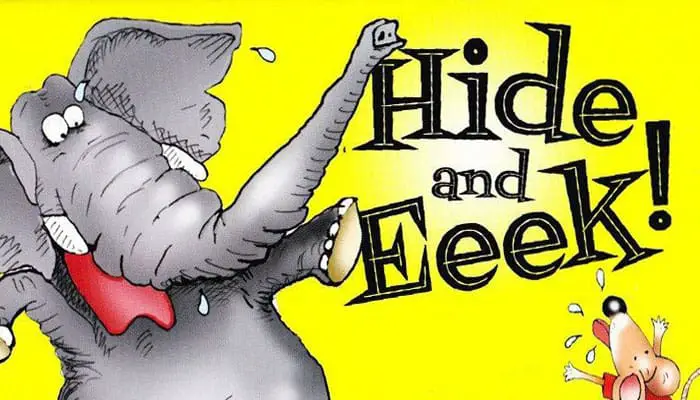

Components
- 100 elephant cards (numbered 1-100)
- 1 mouse figurine
- 1 movement die (numbers in arrows)
- 1 category die (higher/lower/odd/even)
Object of the Game
Move the mouse figurine around the grid of cards looking for numbered elephants that match the category die. The first player to collect 10 elephant cards wins.
Setup
Shuffle the deck and layout 36 elephant cards face down into a 6 by 6 grid.
Deal one card to all players, face up in front of them on the table to start their scoring piles.
Stack the rest of the deck face down to form a draw pile nearby
Place the mouse on one of the cards near the center of the grid.

Game Play

The player who can make the best elephant noise starts the game and play continues to the left. On your turn, roll the dice.
Move the mouse over the cards, either horizontally or vertically (or a combination of the two), the number indicated by the movement die. You may not back track. Now look at the category die.
The goal is to collect cards adjacent (left, right, up, down) to the mouse that match what's indicated on the category die.
Category die options:

Higher / Lower: The number on the card you turn over or choose must either be higher or lower than the top card of your scoring pile.
For example, let's say you have a 46 on top of your scoring pile, and you roll "higher". You'll have to turn up or choose a card with a number higher than 46 to keep the card.

Odd / Even: The card you turn over or choose must either have an odd or even number. For example, if the category die indicates "odd", and the number on the card you turn up is 37, you may take it.
Collecting Cards

Choose any card that's adjacent to the one where the mouse landed and turn it face up. If the number on the card does not match the category die, your turn ends immediately.
Leave the card in the grid, either turned face up or face down, depending on the direction of the arrow on the movement die.
 means face up,
means face up,  means face down. Pass the dice to the next player.If the number on the card matches the category die, you have to make a decision: 1. Take the card and end your turn, or 2. Try to collect more cards.
means face down. Pass the dice to the next player.If the number on the card matches the category die, you have to make a decision: 1. Take the card and end your turn, or 2. Try to collect more cards.
-
End your turn
If you choose to end your turn, add the card face up to the top of your scoring pile. Then fill in the grid with the top card from the draw pile.
Place the replacement card either face up or face down, depending on the direction of the arrow on the movement die. Pass the dice to the next player.
-
Try to collect more cards
If you choose to try collecting more cards, you may select another adjacent card, and if it also matches the category die, you may add it to your scoring pile.
Depending on where the mouse landed, you may collect up to 4 cards during your turn. You may also stop at any time. If you are able to collect all the adjacent cards, you get to take a bonus turn.
But if at any point a card doesn't match the category die, your turn ends and you must discard all the cards you just collected to the bottom of the draw pile. Fill in cards from the draw pile according to the arrow on the movement die.
Note: If you rolled Higher or Lower, additional cards must be higher or lower than the last card you chose or turned over.
Eek

Several cards feature the mouse hiding somewhere on it.
If the card you turn up shows the mouse, the first player to grab the mouse figurine and shout "Eeek!" gets the card and the next turn.
Look carefully, as the mouse can sometimes be camouflaged! Fill in the empty space with a card from the draw pile, according to the arrow on the movement die, and put the mouse back on the card it came from.
Note: If you later notice a mouse on a face up card in the grid, you may also grab the mouse figurine!
Face Up / Face Down Cards
As play progresses, some cards will be left face up in the grid. Make note of the face up cards and try to move the mouse next to them if they match the category die.
Also, try to remember (like an elephant!) the cards you see, because they may not be showing for long!
End of the Game
The first player to collect 10 cards wins. For a longer or shorter game, set a different target amount before playing.
Continue Reading
